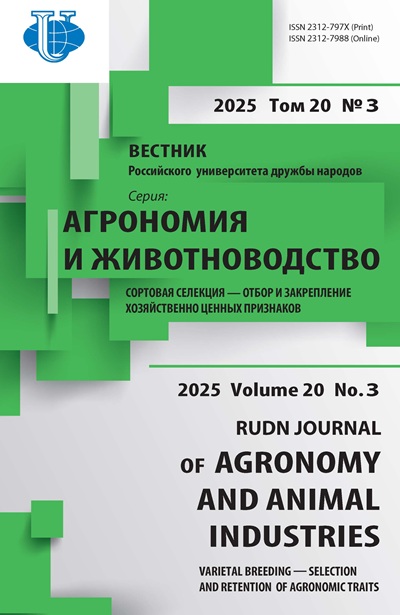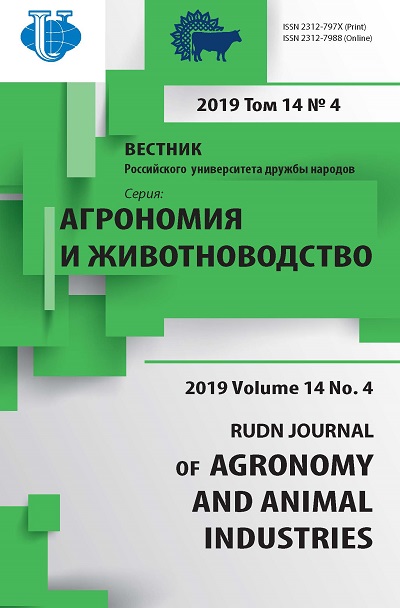Молекулярная идентификация нематоды Ditylenchus destructor методом полимеразной цепной реакции с использованием специфических праймеров в Московской области
- Авторы: Махмуди Н.1,2, Насерзаде Ю.1,2, Пакина Е.Н.1, Лиманцева Л.А.2, Неджад Д.К.3
-
Учреждения:
- Российский университет дружбы народов
- Всероссийский центр карантина растений (ВНИИКР)
- Университет Семнан
- Выпуск: Том 14, № 4 (2019)
- Страницы: 430-436
- Раздел: Защита растений
- URL: https://agrojournal.rudn.ru/agronomy/article/view/19528
- DOI: https://doi.org/10.22363/2312-797X-2019-14-4-430-436
- ID: 19528
Цитировать
Полный текст
Аннотация
Картофель Solanum tuberosum L. - одна из наиболее важных продовольственных и технических культур, а Ditylenchus destructor является патогенной нематодой картофеля и числится в качестве карантинного вредного организма во многих странах и регионах. Поэтому был оптимизирован протокол полимеразной цепной реакции (ПЦР), который надежно и быстро идентифицирует деструктор Ditylenchus. Видоспецифичный внутренний транскрибируемый спейсер (ITS) использовали в качестве праймера гена рибосомальной ДНК деструктора Ditylenchus. Некоторые популяции этого вида в Московской области были исследованы с помощью видоспецифического праймера ПЦР. Новая последовательность из ITS-рРНК была депонирована в GenBank под инвентарным номером MN122076. Современная молекулярная техника лучше подходит для различения видов нематод, поскольку она практична, быстра и точна.
Об авторах
Нилоуфар Махмуди
Российский университет дружбы народов; Всероссийский центр карантина растений (ВНИИКР)
Автор, ответственный за переписку.
Email: niloofarmahmoodi@ymail.com
аспирант, агробиотехнологический департамент, Аграрно-технологический институт
Москва, Российская ФедерацияЮсеф Насерзаде
Российский университет дружбы народов; Всероссийский центр карантина растений (ВНИИКР)
Email: unaserzadeh@gmail.com
аспирант, агробиотехнологический департамент, Аграрно-технологический институт
Москва, Российская ФедерацияЕлена Николаевна Пакина
Российский университет дружбы народов
Email: e-pakina@yandex.ru
кандидат биологических наук, доцент, агробиотехнологический департамент, Аграрнo-технологический институт
Москва, Российская ФедерацияЛюдмила Алексеевна Лиманцева
Всероссийский центр карантина растений (ВНИИКР)
Email: Limantseva.ludmila@vniikr.ru
кандидат биологических наук, старший научный сотрудник
Московская область, Российская ФедерацияДавуд Картули Неджад
Университет Семнан
Email: Kartooli58@gmail.com
доцент кафедры лесоводства, факультет исследований пустынь
Семнан, ИранСписок литературы
- López M, Riegel R, Lizana C, Behn A. Identification of virus and nematode resistance genes in the Chilota Potato Genebank of the Universidad Austral de Chile. Chilean journal of agricultural research. 2015; 75(3):320-327. doi: 10.4067/S0718-58392015000400008
- Scurrah MI, Niere B, Bridge J. Nematode parasites of solanum and sweet potatoes. In: Luc M, Sikora RA, Bridge J. (eds.) Plant parasitic nematodes in subtropical and tropical agriculture. 2nd ed. Wallingford, UK: CABI Publishing; 2005. p. 193-219. doi: 10.1079/9780851997278.0193
- Hijmans RJ. The effect of climate change on global potato production. American journal of potato research. 2003; 80(4):271-279. doi: 10.1007/BF02855363
- Nicol JM, Turner SJ, Coyne DL, Den Nijs L, Hockland S, Maafi ZT. Current nematode threats to world agriculture. In: Jones J, Gheysen G, Fenoll C. (eds.) Genomics and molecular genetics of plant-nematode interactions. Dordrecht: Springer; 2011. p. 21-43. doi: 10.1007/978-94-0070434-3_2
- Fortuner R. On the genus Dilylenchus Filipjev, 1936 (Nernatoda: Tylenchida). Revue Nematol. 1982; 5(1):17-38.
- Thorne G. Ditylenchus destructor n. sp. the potato rot nematode, and Ditylenchus dipsaci (Kühn, 1857) Filipjev, 1936, the teasel nematode (Nematoda: Tylenchidae). Proceedings of the helminthological Society of Washington. 1945; 12(2):27-34.
- Plowright RA, Caubel G, Mizen KA. Plant resistance to parasitic nematodes. In: Starr JL, Cook R, Bridge J. (eds.) Ditylenchus species. Wallingford, UK: CABI Publishing; 2002. p. 107- 139. doi: 10.1079/9780851994666.0107
- Hodda M, Nobbs J. A review of current knowledge on particular taxonomic features of the Australasian nematode fauna, with special emphasis on plant feeders. Australasian Plant Pathology. 2008; 37(3):308-317. doi: 10.1071/AP08024
- Kruus E. Impact of trade on distribution of potato rot nematode (Ditylenchus destructor) and other plant nematodes. Agronomy Research. 2012; 10(1-2):319-328.
- Powers TJARP. Nematode molecular diagnostics: from bands to barcodes. Annu Rev Phytopathol. 2004; 42:367-383. doi: 10.1146/annurev.phyto.42.040803.140348
- Naserzadeh Y, Kartoolinejad D, Mahmoudi N, Zargar M, Pakina E, Heydari M, Astarkhanova T, Kavhiza NJ. Nine strains of Pseudomonas fluorescens and P. putida: Effects on growth indices, seed and yield production of Carthamus tinctorius L. Research on Crops. 2018; 19(4):622- 632. doi: 10.31830/2348-7542.2018.0001.39
- Marek M, Zouhar M, Rysanek P, Havranek P. Analysis of ITS sequences of nuclear rDNA and development of a PCR-based assay for the rapid identification of the stem nematode Ditylenchus dipsaci (Nematoda: Anguinidae) in plant tissues. Helminthologia. 2005; 42(2):49-56.
- Esquibet M, Grenier E, Plantard O, Andaloussi FA, Caubel G. DNA polymorphism in the stem nematode Ditylenchus dipsaci: development of diagnostic markers for normal and giant races. Genome. 2003; 46(6):1077-1083. doi: 10.1139/g03-072
- Subbotin SA, Madani M, Krall E, Sturhan D, Moens M. Molecular diagnostics, taxonomy, and phylogeny of the stem nematode Ditylenchus dipsaci species complex based on the sequences of the internal transcribed spacer-rDNA. Phytopathology. 2005; 95(11):1308-1315. doi: 10.1094/PHYTO-95-1308
- Naserzadeh Y, Mahmoudi N. Chelating effect of black tea extract compared to citric acid in the process of the oxidation of sunflower, canola, olive, and tallow oils. International Journal of Agricultural and Biosystems Engineering. 2018; 12 (5): 5. doi: 10.13140/RG.2.2.12552.26887
- Fand BB, Amala U, Yadav D, Rathi G, Mhaske SH, Upadhyay A, et al. Bacterial volatiles from mealybug honeydew exhibit kairomonal activity toward solitary endoparasitoid Anagyrus dactylopii. Journal of Pest Science. 2019:1-12. doi: 10.1007/s10340-019-01150-4
- OEPP/EPPO. PM 7/87(2) Ditylenchus destructor and Ditylenchus dipsaci. Bulletin OEPP/ EPPO Bulletin. 2017; 47(3):401-419. doi: 10.1111/epp.12433
- Naserzadeh Y, Mahmoudi N, Pakina E. Antipathogenic effects of emulsion and nanoemulsion of cinnamon essential oil against Rhizopus rot and grey mold on strawberry fruits. Foods and Raw materials. 2019; 7(1):210-216. doi: 10.21603/2308-4057-2019-1-210-216
Дополнительные файлы















